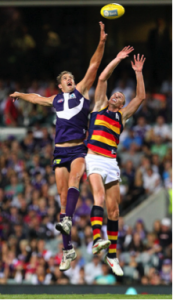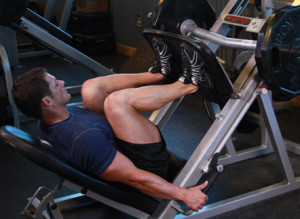The truth about the leg press if you’re a footy player
Especially if it is your vertical leap that you are most wanting to work on…..
If you’re a footy player, and aiming to improve your vertical leap, you may have considered performing leg presses in order to enhance your leg strength, and hence create more potential within your legs to jump higher. However, this would be a big mistake, and not only will the leg press do absolutely nothing to improve your vertical leap, it will also often contribute to decreasing your vertical leap ability. Here are the key reasons why.
1. The old trap of thinking of muscles, not movements
We have covered this topic repeatedly in other articles and particularly in Functional Strength Training for Australian Rules, so you already have had it drummed into your head that strength training for footy is about training certain movements and movement qualities via the nervous system, rather than just blasting certain muscles. Simply hammering your quads on the leg press, where you are either lying or seated, and fully supported by the machine, does not mean that your quads will then transfer this strength over to a standing position, where you now must also use your hips to initiate a jump. Make no mistake, a leg press is nothing like a jump movement, it just uses similar muscles. But we are about movement quality, not muscles.
2. There is no Generalised Motor Program Compatibility
This is another point which overlaps with other discussion topics elsewhere, but everytime you re-read these points, they will make more and more sense. Following on from the last point, for an exercise to be functional for football, it must train very similar movement patterns to those that are performed on match day. This similar movement pattern, or high level of carryover to a movement quality on game day is an example of motor program compatibility. In layman’s terms, a motor program is basically a particular movement or a movement quality that is ‘stored’ in your nervous system. For example, a squat is a similar motor program to a jump off 2 feet, a step up is a similar motor program to a jump of 1 foot, as these require not only similar movements and in similar positions, but also, similar relative timing of the muscles involved. Or in other words, the muscles involved in the movement are contributing at the same relative time (to each other) as they are in the associated movements in a match situation.
However do not be tricked into thinking that a leg press would have a similar carryover to the double leg jump as a squat does, because a leg press and a vertical jump are not similar generalised motor programs and a leg press and a vertical jump do not have similar relative timing in movements. A leg press is useless for movements in football. For starters, a leg press virtually isolates your knee joint; there is no hip involvement at all because it is locked in place. Ok great, so we have already eliminated the primary joint responsible for jumping (the hip) from the movement, but then to top it off, we are also sitting down, or lying on a 45- degree angle. These are positions and movements that you will never find your self in and never be required to perform in a game of footy, and therefore, there is no carryover via a generalised motor program as there is with a squat.
There is no comparison between these 2 movements. Although they appear similar because of the muscles involved, a leg press requires no use of the hips, no transfer of power from the ground up through the legs and core, and no activation of the core and torso at all! The squat requires all of these.



With most jumps occurring off 1 leg, a step up has even more carryover to this movement than a squat does.
3. Aren’t most jumps performed off of 1 leg anyway?
Spot on! Of course they are. Look at most contests in the air, be they a ruck contest, or a defender jumping at a ball to punch it clear of the defensive zone, the overwhelming majority of jumps are performed off of 1 leg. There are double legged jumps too, but they are far outweighed by those performed off of 1 leg. And remember what we just covered about movements not muscles, as well as motor program compatibility. This is another example of it here. Whilst squats are a great baseline for developing vertical leap ability off 2 legs (when programmed correctly of course), they have much lower carryover to a vertical leap off 1 leg (although they will still have more than the 0% carryover that a leg press has) as this is a different motor program. A step up therefore, will have more carryover to a single leg jump than a squat. Notice how leg presses aren’t even in the picture anymore when discussing the types of exercises for different types of jumps?
4. Adding size to your legs means you need more power just to maintain the same height.
A short and sharp point here. If you are putting on muscle mass around your legs from ding heaps of peg presses, you will all of a sudden weigh more, and therefore require more strength and more power for jumping (let alone higher cardio-respiratory output when running, etc) just to maintain your existing vertical leap. However, you already know that a leg press doesn’t actually improve your vertical leap due to not being a movement with any sort of carryover via motor program compatibility, and therefore if you do put on size around the thighs from leg presses, your vertical leap will actually be diminished.
A key point to be cover quickly – leg press as ‘assistance work’
Many guys reading this would be thinking, ‘yeh this may all be well and good with respect to the functionality and carryover of a leg press itself to game day, but leg press is still a god assistance exercise for squats.’ This is a commonly held belief, however I would ask assistance for what exactly? Leg strength to assist with your squat would be the most likely answer, however this is missing the point a little, as your leg strength is never the limiting factor in being able to lift a squat at a certain weight. It is your torso’s ability to maintain proper posture and adequate core activation that will falter long before your legs give out on a squat. Proof of this the fact that you can leg press at least double, and usually more, than you can squat. In other words, your leg strength isn’t the limiting factor requiring assistance in order to squat more, but rather core strength and torso stability under load.
5. A leg press is only 1 exercise anyway, and no 1 exercise outdoes a periodised program.
There is no exercise around that will be optimal for developing a quality such as jumping. We already by this point know that leg presses are useless for this task, however no 1 exercise by itself will provide optimal results. Certainly exercises like squats and step-ups are far more beneficial and will have a much higher level of carryover. However, the ideal training in order to provide the optimal results is a program structured to follow the principles of peridoisation, which includes both functional strength training exercises, as well as footy specific plyometric style drills. These exercises then must be programmed correctly with the appropriate sets and reps and rest times, as well as tempos, throughout the year.
Functional Continuum for training for a stationary double-leg jump – Taken from Functional Strength Training for Australian Rules Football
There is a lot of information and key concepts in this article, so re-read it and internalise it. Remember when searching for effective exercises to develop any movement quality, look for exercises which have a high level of carryover via a similar motor program, and then train this movement with the appropriate sets and reps scheme, as part of a periodised program. The first step in this process is to drop the leg press, and head over to the squat rack and perform more squats and step ups.
Strength Coach




